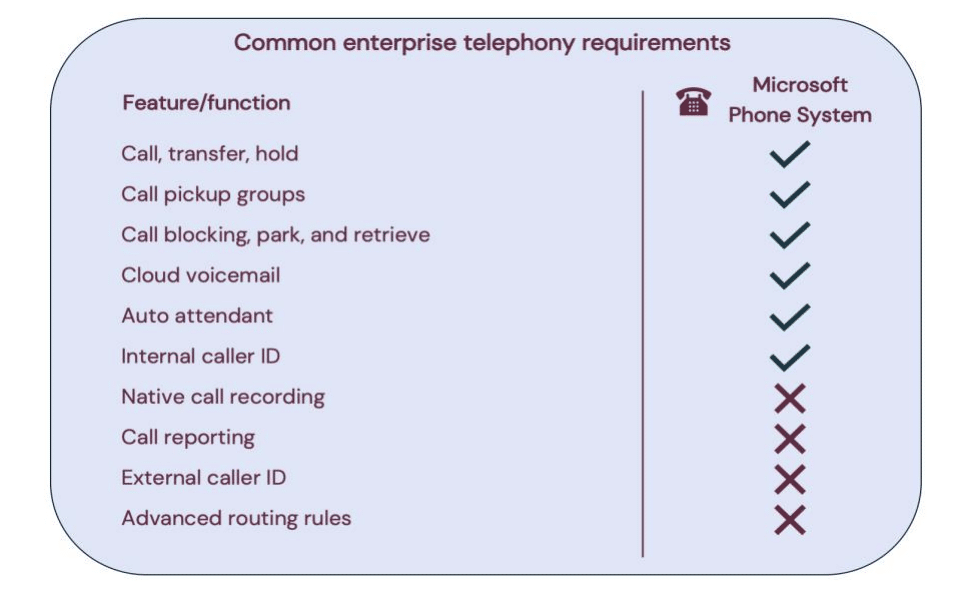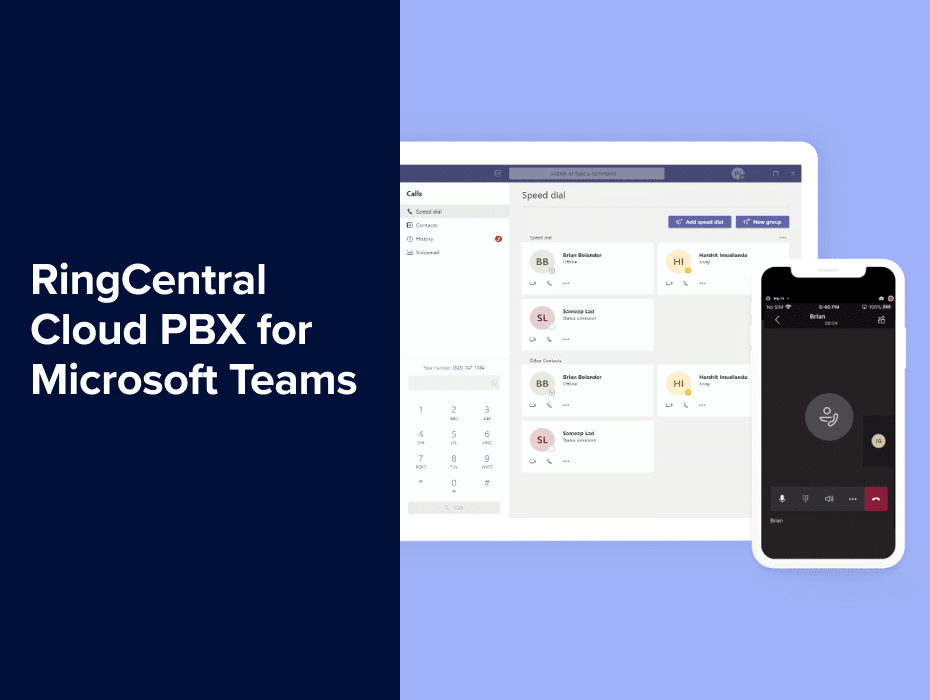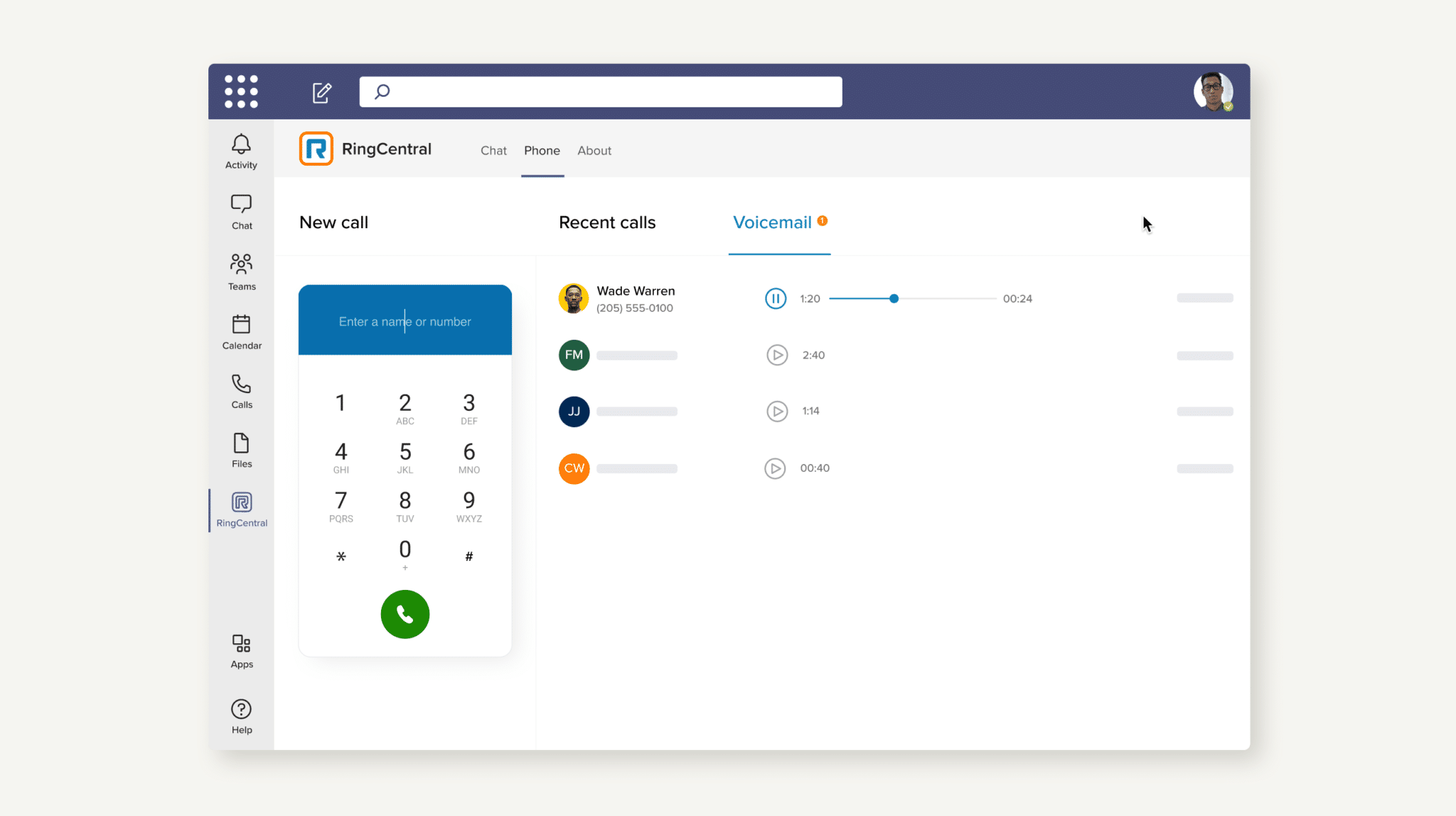Highlights:
- The built-in telephony in Microsoft Teams—and its respective Calling Plans—often don’t meet the needs of enterprise users.
- Direct routing connects third-party telephony carriers into Microsoft Teams.
- From out-the-box deployment to 99.999% uptime SLA, here are a few reasons to consider RingCentral Cloud PBX for your Microsoft Teams direct routing.
Messaging, video meetings, emails—businesses today have a number of communication tools to choose from.
Yet, when it comes to connecting with colleagues and customers, phone calls still reign supreme. In fact, phone calls rank as the second most popular choice for internal and external communication, right behind email for most.

This brings us to Microsoft Teams and its native voice services. Many businesses choose Microsoft Teams for its suite of communication tools, including messaging and video. The problem is, their phone features leave a lot to be desired for many enterprise users. So much so that businesses might seek other options to Microsoft’s own Calling Plans.
Direct routing: The basics
Luckily, Microsoft Teams offers an alternative: direct routing. Businesses can connect their preferred third party telephony solution to Microsoft Teams for PSTN connectivity. This involves managing with their own Session Border Controller (SBC) hardware/software to connect SIP trunks to the outside world, or having it managed by their direct routing provider.
Direct routing can be broken down into three types:
- Basic access: Includes SIP connectivity but no phone numbers, calling minutes or advanced features, and limited support provisions.
- Direct routing as a service: A subscription model that includes SIP connectivity, SBC provision and management, phone numbers, calling minutes, and only a few overlay features.
- Enhanced Microsoft Teams telephony service: Built on the features of direct routing as a service but also includes multiple additional advanced features.
Choosing the right direct routing option will depend on your needs. But if you’re looking for a complete package of enterprise-grade Cloud PBX, RingCentral Cloud PBX for Microsoft Teams might be the solution for your direct routing needs.
Let’s look at several advantages of having RingCentral as a partner for your Microsoft Teams deployment:
1. Ease of use
There’s a lot to consider when looking for a direct routing solution, but we look at it from a bottom-up approach: what do most of your users need? Some might want more advanced features such as call reports and analytics, but when it comes to everyday users, most just want a simple interface with calling capabilities right in their Teams application.
Our solution:
With RingCentral Cloud PBX, you can keep users at the center of the Teams experience. Phone capabilities—such as the RingCentral dialer—are embedded natively into Teams so users never have to leave the app to make calls. The combination of phone, video, and messaging gives your entire workforce a unified suite of communication tools all in one convenient location.
What’s more, native PTSN in 40+ countries and virtual numbers in more than 100 nations around the world allows your users to reach anywhere they need to connect, with emergency services available at all of these locations. We also guarantee quality of service globally with 30+ data centers, 40+ carriers, and 200+ ISPs.
2. Enterprise-grade features

Microsoft Teams comes with a set of basic voice features, but sometimes, enterprises need more. For example, native functions such as caller ID management and call recording aren’t included in Teams’ Phone System.
Also, users might want both their unified communications and contact center capabilities in the same interface. That’s where RingCentral comes in.
Our solution:
The RingCentral platform—which comes with your direct routing service—offers more advanced features that meet enterprise users’ needs.
For example, users have access to advanced call queueing and custom IVR capabilities that help route inbound calls. Sales agents have access to their favorite CRM integrations (such as Salesforce). IT administrators can look into call analytics and gain actionable insights into call quality, device connectivity, and other critical KPIs.
Additionally, whereas Microsoft Teams has undergone several pivots in its lifetime, RingCentral has always specialized in pure cloud communications—with over 20 years of experience addressing telephony’s biggest pain points.

3. Reliability: 99.999% uptime SLA
Downtime brings collaboration to a standstill—and in a future where work happens anywhere and anytime, losing even minutes of service can affect your business. Whether they’re planned shutdowns for updates or unexpected outages, your service provider should guarantee a certain level of uptime SLA.
Service disruptions continue to plague Microsoft Teams, many of which last for hours. At the same time, Microsoft guarantees an uptime SLA of only 99.9%, which equates to nearly nine hours of downtime per year.
Our solution:
RingCentral offers several advantages in the way of uptime and reliability.
Our 99.999% uptime SLA is the gold standard in cloud services. Compared to Microsoft Teams’ own SLA, RingCentral users experience only six minutes of downtime per year. And when every minute counts, teams can collaborate with confidence knowing that their communications are backed by RingCentral’s high standards for reliability and business continuity.
In the event of a service disruption (such as a power outage or natural disaster), Microsoft Teams users have another option: the RingCentral App. Accessible from any device (PC, smartphone, tablet), the RingCentral App gives your users multiple ways to access their communications and peace of mind that they’re not missing any important calls.
4. Ready to deploy right out of the box
Deploying direct routing for Microsoft Teams without the help of a third-party provider requires a considerable amount of technical and financial capability. IT teams would need to know how to use Powershell—Microsoft’s proprietary management framework—as well as an SBC device to connect SIP trunks to the outside world.
Our solution:
With RingCentral Cloud PBX for Microsoft Teams, you can leave the operation entirely up to us. We maintain and operate the complete high-availability Teams Direct Routing infrastructure using MSFT-certified SBCs—so you don’t have to.
What’s more, the system can be easily managed via an intuitive, accessible-anywhere admin portal. Other than Teams license requirements, there are no additional RingCentral Cloud PBX fees for leveraging direct routing, and can be set up easily by engaging RingCentral Professional Services through a package which includes configuration, three hours of admin training, and ongoing support to address any technical issues.
5. Do more with third-party business apps
Today’s workers use much more than just communication apps for their day-to-day work. Calendars, CRMs, ERP, HR tools—chances are your organization use hundreds of business apps every day across different teams.
Our solution:
RingCentral’s native out-of-the-box and custom integrations simplify the communications experience and eliminate having to switch between multiple applications by connecting RingCentral with your users’ favorite apps.
For example, you can schedule, start, or join video meetings directly from Microsoft Teams and access phone capabilities right from Teams chat or integrate productivity and call efficiency into Salesforce. No matter your workflow, our open platform can be customized to meet your unique business needs.
Get more done with Microsoft Teams
Whether your users need advanced features not available in Teams, or just want a robust phone system in their Teams interface, RingCentral has all of your bases covered.
Don’t just take our word for it. Gartner recognized us as a Magic Quadrant Leader in UCaaS for six years in a row. And Omdia for four years in a row.

Originally published Apr 22, 2021, updated Jul 23, 2024





